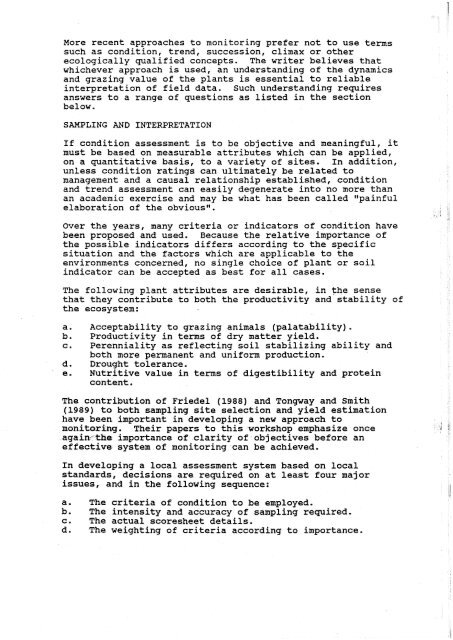soil-conservation-people-religion-and-land.pdf - South West NRM
soil-conservation-people-religion-and-land.pdf - South West NRM
soil-conservation-people-religion-and-land.pdf - South West NRM
You also want an ePaper? Increase the reach of your titles
YUMPU automatically turns print PDFs into web optimized ePapers that Google loves.
More recent approaches to monitoring prefer not to use terms<br />
such as condition, trend, succession, climax or other<br />
ecologically qualified concepts. The writer believes that<br />
whichever approach is used, an underst<strong>and</strong>ing of the dynamics<br />
<strong>and</strong> grazing value of the plants is essential to reliable<br />
interpretation of field data. Such underst<strong>and</strong>ing requires<br />
answers to a range of questions as listed in the section<br />
below.<br />
SAMPLING AND INTERPRETATION<br />
If condition assessment is to be objective <strong>and</strong> meaningful, it<br />
must be based on measurable attributes which can be applied,<br />
on a quantitative basis, to a variety of sites. In addition,<br />
unless condition ratings can ultimately be related to<br />
management <strong>and</strong> a causal relationship established, condition<br />
<strong>and</strong> trend assessment can easily degenerate into no more than<br />
an academic exercise <strong>and</strong> may be what has been called "painful<br />
elaboration of the obvi~us~~.<br />
Over the years, many criteria or indicators of condition have<br />
been proposed <strong>and</strong> used. Because the relative importance of<br />
the possible indicators differs according to the specific<br />
situation <strong>and</strong> the factors which are applicable to the<br />
environments concerned, no single choice of plant or <strong>soil</strong><br />
indicator can be accepted as best for all cases.<br />
The following plant attributes are desirable, in the sense<br />
that they contribute to both the productivity <strong>and</strong> stability of<br />
the ecosystem:<br />
a. Acceptability to grazing animals (palatability).<br />
b. Productivity in terms of dry matter yield.<br />
c. Perenniality as reflecting <strong>soil</strong> stabilizing ability <strong>and</strong><br />
both more permanent <strong>and</strong> uniform production.<br />
d. Drought tolerance.<br />
e. Nutritive value in terms of digestibility <strong>and</strong> protein<br />
content.<br />
The contribution of Friedel (1988) <strong>and</strong> Tongway <strong>and</strong> Smith<br />
(1989) to both sampling site selection <strong>and</strong> yield estimation<br />
have been important in developing a new approach to<br />
monitoring. Their papers to this workshop emphasize once<br />
again- the importance of clarity of.objectives before an<br />
effective system of monitoring can be achieved.<br />
In developing a local assessment system based on local<br />
st<strong>and</strong>ards, decisions are required on at least four major<br />
issues, <strong>and</strong> in the following sequence:<br />
a. The criteria of condition to be employed.<br />
b. The intensity <strong>and</strong> accuracy of sampling required.<br />
c. The actual scoresheet details.<br />
d. The weighting of criteria according to importance.
















